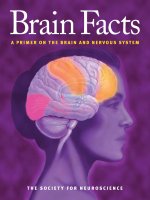Making up the mind how the brain creates our mental world
Bạn đang xem bản rút gọn của tài liệu. Xem và tải ngay bản đầy đủ của tài liệu tại đây (3.93 MB, 247 trang )
Praise for Making up the Mind
“Chris Frith is well known for his extremely clear thinking on very complex psychological matters, such as agency, social intelligence, and the
minds of people with autism and schizophrenia. And it is precisely such
questions, along with the understanding of how we perceive, act, choose,
remember, and feel, which are now being revolutionized by brain imaging.
In Making up the Mind, he brings all this together in a most accessible
and engaging way.”
Oliver Sacks, MD
“Making up the Mind is a fascinating guided tour through the elusive
interface between mind and brain written by a pioneer in the field. The
author’s obvious passion for the subject shines through every page.”
V.S. Ramachandran, MD
“I soon made up my mind that this is an excellent, most readable and
stimulating book. The author is a distinguished neuroscientist working
especially on brain imaging.”
R.L. Gregory, University of Bristol
“Chris Frith, one of the pioneers in applying brain imaging to study
mental processes, has written a brilliant introduction to the biology of
mental processes for the general reader. This superb book describes how
we recreate in our brains a representation of the external world. Clearly
and beautifully written, this book is for all who want to learn about
how the brain gives rise to the mental phenomenon of our lives. A must
read!”
Eric R. Kandel, Nobel Laureate
“Important and surprising. The brain will never seem the same again.”
Lewis Wolpert, University College London
For Uta
Making up the Mind
How the Brain Creates our Mental World
Chris Frith
© 2007 by Chris D. Frith
BLACKWELL PUBLISHING
350 Main Street, Malden, MA 02148-5020, USA
9600 Garsington Road, Oxford OX4 2DQ, UK
550 Swanston Street, Carlton, Victoria 3053, Australia
The right of Chris D. Frith to be identified as the Author of this Work
has been asserted in accordance with the UK Copyright, Designs, and Patents
Act 1988.
All rights reserved. No part of this publication may be reproduced, stored in a
retrieval system, or transmitted, in any form or by any means, electronic,
mechanical, photocopying, recording or otherwise, except as permitted by the
UK Copyright, Designs, and Patents Act 1988, without the prior permission
of the publisher.
First published 2007 by Blackwell Publishing Ltd
1
2007
Library of Congress Cataloging-in-Publication Data
Frith, Christopher D.
Making up the mind : how the brain creates our mental world / Chris Frith.
p. cm.
Includes bibliographical references and index.
ISBN 978–1–4051–3694–5 (hardcover : alk. paper)—
ISBN 978–1–4051–6022–3 (pbk. : alk. paper) 1. Brain—Popular works.
2. Human behavior—Physiological aspects. 3. Neuropsychiatry—Popular
works. 4. Neuropsychology—Popular works. I. Title.
QP376.F686 2007
612.8′2—dc22
2006038336
A catalogue record for this title is available from the British Library.
Set in 10/13pt Galliard
by Graphicraft Limited, Hong Kong
Printed and bound in Singapore
by COS Printers Pte Ltd
The publisher’s policy is to use permanent paper from mills that operate a
sustainable forestry policy, and which has been manufactured from pulp
processed using acid-free and elementary chlorine-free practices. Furthermore,
the publisher ensures that the text paper and cover board used have met
acceptable environmental accreditation standards.
For further information on
Blackwell Publishing, visit our website:
www.blackwellpublishing.com
Contents
List of Abbreviations
Preface
Acknowledgments
ix
x
xi
Prologue: Real Scientists Don’t Study the Mind
The Psychologist’s Fear of the Party
Hard Science and Soft Science
Hard Science – Objective; Soft Science – Subjective
Can Big Science Save Soft Science?
Measuring Mental Activity
How Can the Mental Emerge from the Physical?
I Can Read Your Mind
How the Brain Creates the World
1
1
3
5
7
9
15
16
16
Part I
Seeing through the Brain’s Illusions
19
Clues from a Damaged Brain
Sensing the Physical World
The Mind and the Brain
When the Brain Doesn’t Know
When the Brain Knows, But Doesn’t Tell
When the Brain Tells Lies
How Brain Activity Creates False Knowledge
How to Make Your Brain Lie to You
Checking the Reality of Our Experiences
How Do We Know What’s Real?
21
21
22
24
27
29
31
34
36
37
1
vi
Contents
2
What a Normal Brain Tells Us about the World
Illusions of Awareness
Our Secretive Brain
Our Distorting Brain
Our Creative Brain
40
40
44
48
50
3
What the Brain Tells Us about Our Bodies
Privileged Access?
Where’s the Border?
We Don’t Know What We Are Doing
Who’s in Control?
My Brain Can Act Perfectly Well without Me
Phantoms in the Brain
There’s Nothing Wrong with Me
Who’s Doing It?
Where Is the “You”?
61
61
61
64
66
68
70
74
75
77
Part II
How the Brain Does It
4
Getting Ahead by Prediction
Patterns of Reward and Punishment
How the Brain Embeds Us in the World and Then Hides Us
The Feeling of Being in Control
When the System Fails
The Invisible Actor at the Center of the World
5
Our Perception of the World Is a Fantasy That
Coincides with Reality
Our Brain Creates an Effortless Perception of the
Physical World
The Information Revolution
What Can Clever Machines Really Do?
A Problem with Information Theory
The Reverend Thomas Bayes
The Ideal Bayesian Observer
How a Bayesian Brain Can Make Models of the World
Is There a Rhinoceros in the Room?
Where Does Prior Knowledge Come From?
83
85
85
100
105
107
109
111
111
112
116
117
119
123
125
125
127
Contents vii
6
How Action Tells Us about the World
My Perception Is Not of the World, But of My Brain’s
Model of the World
Color Is in the Brain, Not in the World
Perception Is a Fantasy That Coincides with Reality
We Are Not the Slaves of Our Senses
So How Do We Know What’s Real?
Imagination Is Extremely Boring
130
How Brains Model Minds
Biological Motion: The Way Living Things Move
How Movements Can Reveal Intentions
Imitation
Imitation: Perceiving the Goals of Others
Humans and Robots
Empathy
The Experience of Agency
The Problem with Privileged Access
Illusions of Agency
Hallucinating Other Agents
139
140
141
144
145
148
149
151
155
156
157
Part III
7
Culture and the Brain
Sharing Minds – How the Brain Creates Culture
The Problem with Translation
Meanings and Goals
Solving the Inverse Problem
Prior Knowledge and Prejudice
What Will He Do Next?
Other People Are Contagious
Communication Is More Than Just Speaking
Teaching Is Not Just a Demonstration To Be Imitated
Closing the Loop
Fork Handles: The Two Ronnies Close the Loop (Eventually)
Fully Closing the Loop
Knowledge Can Be Shared
Knowledge Is Power
The Truth
132
134
134
135
136
137
161
163
163
165
166
167
168
169
170
171
173
174
175
175
177
179
viii Contents
Epilogue: Me and My Brain
Chris Frith and I
Searching for the Will in the Brain
Where Is the Top in Top-Down Control?
The Homunculus
This Book Is Not About Consciousness
Why Are People So Nice (as Long as They Are Treated Fairly)?
Even an Illusion Has Responsibilities
184
184
185
186
188
189
190
191
The Evidence
Illustrations and Text Credits
Index
194
218
226
Abbreviations
BOLD
CAT
EEG
FFA
fMRI
MRI
PET
PPA
REM
TD
blood oxygenation level dependent
computerized axial tomography
electroencephalogram
fusiform face area
functional magnetic resonance imaging
magnetic resonance imaging
positron emission tomography
parahippocampal place area
rapid eye movement
temporal difference
Preface
Inside my head there is an amazing labor-saving device. Better even than
a dishwasher or a calculator, my brain releases me from the dull, repetitive task of recognizing the things in the world around me, and even
saves me from needing to think about how to control my movements.
I can concentrate on the important things in life: making friends and
sharing ideas. But, of course, my brain doesn’t just save me from tedious
chores. My brain creates the “me” that is released into the social world.
Moreover, it is my brain that enables me to share my mental life with
my friends and thereby allows us to create something bigger than any of
us are capable of on our own. This book describes how the brain makes
this magic.
Acknowledgments
My work on the mind and the brain has been possible through funding
from the Medical Research Council and the Wellcome Trust. The MRC
enabled my work on the neuropsychology of schizophrenia through its
support of Tim Crow’s psychiatry unit in the Clinical Research Centre
at Northwick Park Hospital in Harrow, Middlesex. At that time we
could only make indirect inferences about relationships between the
mind and the brain, but this all changed in the 1980s with the development of brain scanners. The Wellcome Trust enabled Richard Frackowiak
to create the Functional Imaging Laboratory and supported my investigations there into the neural correlates of consciousness and social
interactions. The study of the mind and the brain cuts across traditional
disciplines, from anatomy and computational neurobiology to philosophy
and anthropology. I have been fortunate that I have always worked in
multidisciplinary – and multinational – groups.
I have benefited greatly from my interactions with my colleagues and
friends at University College London, in particular Ray Dolan, Dick
Passingham, Daniel Wolpert, Tim Shallice, Jon Driver, Paul Burgess, and
Patrick Haggard. At the early stages of this book I had many fruitful
discussions on the brain and the mind with my friends at Aarhus, Jakob
Hohwy and Andreas Roepstorff, and at Salzburg, Josef Perner and Heinz
Wimmer. Martin Frith and John Law have argued with me about many
of the topics covered in this book for as long as I can remember. Eve
Johnstone and Sean Spence generously gave me expert advice on psychiatric phenomena and their significance for brain science.
Perhaps the most important impetus for writing this book came
from my weekly discussions with the breakfast group, past and present.
Sarah-Jayne Blakemore, Davina Bristow, Thierry Chaminade, Jenny Coull,
xii Acknowledgments
Andrew Duggins, Chloë Farrer, Helen Gallagher, Tony Jack, James Kilner,
Hakwan Lau, Emiliano Macaluso, Eleanor Maguire, Pierre Maquet, Jen
Marchant, Dean Mobbs, Mathias Pessiglione, Chiara Portas, Geraint Rees,
Johannes Schultz, Sukhi Shergill, and Tania Singer all have helped to
shape this book. I am deeply grateful to them.
Karl Friston and Richard Gregory read sections of the book and have
given me much help and useful advice. I am grateful to Paul Fletcher for
his encouragement at an early stage to create the Professor of English
and the other characters who argue with the narrator.
Philip Carpenter went well beyond the call of duty to provide incisive
comments.
Most of all I am grateful to those who read all the chapters and
provided detailed comments. Shaun Gallagher and two anonymous readers made many useful suggestions. Rosalind Ridley caused me to think
more carefully about my claims and to be more precise in my terminology. Alex Frith helped me to eliminate jargon and failures of continuity.
Uta Frith was closely involved in all stages of the development of the
project. Without her example and guidance this book would not exist.
Prologue: Real Scientists
Don’t Study the Mind
The Psychologist’s Fear of the Party
Just like any other tribe, scientists have a hierarchy. Psychologists are
somewhere near the bottom. I discovered this in my first year at university, where I was studying natural sciences. It was announced that, for
the first time, students would be able to study psychology in part 1 of the
natural sciences tripos. I went eagerly to my college tutor to ask him if he
knew anything about this new possibility. “Yes,” he replied. “But I didn’t
think any of my students would be crass enough to want to study psychology.” He was a physicist.
Possibly because I was not entirely sure what “crass” meant, I was
undeterred by this remark. I switched from physics to psychology. I have
continued to study psychology ever since, but I have never forgotten
about my place in the hierarchy. Inevitably the question will come up at
academic parties, “so what do you do?” and I think twice about replying,
“I’m a psychologist.”
Of course, much has changed in psychology over the last 30 years.
We have borrowed many skills and concepts from other disciplines. We
study the brain as well as behavior. We use computers extensively to
analyze our data and to provide metaphors for how the mind works.1
My university identity badge doesn’t say “Psychologist,” but “Cognitive
Neuroscientist.”
“So what do you do?” someone asks. I think she’s the new Head of
Physics. Unfortunately the reply, “I’m a cognitive neuroscientist” to the
1
I have to admit that there are a few diehards who deny that the study of the brain or of
computers can tell us anything about how the mind works.
2
Prologue
the human brain
back
front
a slice through the brain
right
hemisphere
left
hemisphere
cortex
gray matter (nerve cells)
ventricles (fluid-filled spaces)
white matter (connecting fibers)
Figure p.1 Whole brain and post-mortem slice
The human brain seen from the side (top). The arrow indicates where this has been sliced to
reveal the lower picture. The brain’s outermost layer (the cortex) consists of gray matter and
is heavily folded in order to fit a large surface area into a small volume. The cortex contains
about 10 billion nerve cells.
Source: University of Wisconsin-Madison Brain Collection 69-314, .
Images and specimens funded by the National Science Foundation, as well as by the National
Institute of Health.
question simply delays matters. After I have tried to explain what I
actually do, she says, “Ah, you’re a psychologist!” with that characteristic
look which I translate to mean, “Wouldn’t you rather be doing real
science?”
The Professor of English joins the conversation and starts talking
about psychoanalysis. One of her new girls is “having difficulty accepting
Freud.” I don’t want to spoil my drinking time by proposing that Freud
was a story-teller whose speculations about the human mind were largely
irrelevant.
A few years ago the editor of the British Journal of Psychiatry, no
doubt in error, asked me to assess a Freudian paper. I was immediately
Prologue 3
struck by a subtle difference from the papers I usually assess. As in any
scientific paper, there were lots of “references.” “References” refer to
papers already published on the same topic. We make these references
partly to acknowledge the work of our predecessors, but mainly to support the claims we make in our own paper. “Don’t just take my word
for it. You will find my methods fully justified in Box & Cox (1964).”2
But no attempt was made to support the evidence in the Freudian paper.
The references were not about the evidence. They were about the ideas.
Using these references you could trace the development of these ideas
through the various followers of Freud back to the original words of the
master himself. No evidence was presented as to whether the ideas of
the master were right.
“Freud may have had a big influence on literary criticism,” I say to the
Professor of English, “but he was no scientist. He wasn’t interested in
evidence. I study psychology scientifically.”
“So,” she replies, “you use the monster of mechanical reason to kill off
our humanity.”3
From both sides of the cultural divide I get the same response,
“Scientists can’t study the mind.” So what’s the problem?
Hard Science and Soft Science
In the dominance hierarchy of science, the top sciences are “hard” while
those at the bottom are “soft.” “Hard” doesn’t mean that the science is
more difficult. “Hard” relates to the subject matter of the science and
the sort of measurements that can be made. Hard things like diamonds
have definite edges that can be measured precisely. Soft things like ice
creams have edges that are ill defined and may vary from one measurement to the next. The hard sciences, such as physics and chemistry, study
tangible things that can be measured very precisely. For example, the
speed of light (in a vacuum) is exactly 299,792,458 meters per second.
An atom of iron is 55.405 times heavier than an atom of hydrogen.
These numbers are very important. From the atomic weights of the
2
Believe it or not, this is a genuine reference to an important statistical method, which
you will find at the end of the book.
3
She is a specialist in the works of the Australian novelist Elizabeth Costello.
4
Prologue
various elements the periodic table could be constructed providing the
first clues about the sub-atomic structure of matter.
Biology used to be a rather softer science than physics and chemistry,
but this changed dramatically with the discovery that genes consist of
precise sequences of base pairs in DNA molecules. For example, the sheep
prion gene has 960 base pairs, starting ctgcagactttaagtgattcttacgtgggc,
etc., etc.
Confronted with this precision of measurement, I have to admit that
psychology is very soft. The most famous number in psychology is 7,
the number of items that can be held in working memory.4 But even
this number has to be qualified. The title of the original paper written
by George Miller in 1956 was “The Magical Number Seven, Plus or
Minus Two.” So the best measurement that psychologists have come
up with can vary by nearly 30%. The number of items you can hold in
working memory varies from time to time and from person to person.
I will remember fewer numbers if I am tired or anxious. As an English
speaker I can remember more numbers than a Welsh speaker.5 “What
did you expect?” says the Professor of English. “You can’t pin down
the human mind like a butterfly in a display case. Each one of us is
different.”
This remark misses the point. Of course each one of us is different. But
there are also properties of the mind that are common to us all. It is
these fundamental properties that psychologists are trying to discover.
Chemists had exactly the same problems with the rocks they were studying before the discovery of the chemical elements in the 18th century.
Every rock was different. In comparison with the “hard” sciences, psychology has had little time to discover what to measure or how to
measure it. Psychology has existed for just over 100 years as a scientific
discipline. I am confident that, in time, psychologists will have discovered
what to measure and will have developed the instruments that will help
us to make these measurements very precisely.
4
Working memory is a form of active short-term memory. This is the kind of memory we
use when we try to keep a telephone number in mind without writing it down. Psychologists and neuroscientists have studied working memory intensively, but have yet to reach
agreement about precisely what it is they are studying.
5
This statement does not reveal some anti-Welsh prejudice, but refers to one of the many
important discoveries psychologists have made about working memory. Welsh speakers
remember fewer numbers because sequences of numbers in Welsh take longer to say than
their English equivalents.
Prologue 5
Hard Science – Objective;
Soft Science – Subjective
These are optimistic words justified by my belief in the inexorable progress
of science.6 The problem is that, for psychology, this optimism may not
be justified. There is something fundamentally different about the things
we are trying to measure.
The measurements made by the hard sciences are objective. They can
be checked. “You don’t believe that speed of light is 299,792,458 meters
per second? Here’s the equipment. Measure it yourself.” Once we have
used the equipment to make the measurement, the numbers come from
dials and print-outs and computer screens that anyone can read. But
psychologists use themselves or their volunteers as measuring instruments. These measurements are subjective. They cannot be checked.
Here is a simple psychological experiment. I program my computer to
display a field of black dots that moves continuously downward from the
top to the bottom of the screen. I stare at the screen for a minute or two.
Then I press escape and the dots stop moving. Objectively the dots are
no longer moving. If I place the point of my pencil on top of one of the
dots, I can check that it is definitely not moving. But I have the very
strong subjective impression that the dots are moving slowly upward.7 If
you came into the room at that moment, you would see the stationary
dots on the screen. I would tell you that the dots seemed to be moving
upward, but how can you check this? The movement is only happening
in my mind.
Of course, everyone can experience this illusion of movement. If you
stared at the moving dots for a minute or two, then you would also see
movement in the stationary dots. But now the movement is in your mind
and I can’t check it. And there are many other experiences that we
cannot share. For example, I could tell you that, whenever I go to a
party, I find myself remembering the face of the professor with whom I
argued about Freud. What sort of an experience is this? Do I really have
an image of her face? Do I remember the event, or do I just remember
6
This belief is not shared by the Professor of English
This phenomenon is known as the waterfall illusion or the motion after-effect. If you
stare at a waterfall for a minute or two and then look at the bushes to the side, you will get
the distinct impression that the bushes are moving upward, even though you can also see
that they are clearly staying in the same place.
7
6
Prologue
writing about the event? Such experiences can never be checked. How
can they be the basis of scientific study?
A real scientist wants to make her own, independent check on the
measurements reported by someone else. “Nullius in verba” is the motto
of the Royal Society of London: “Don’t believe what people tell you,
however authoritative they may be.”8 If I followed this principle, then
I would have to agree that the scientific study of your mental life is
impossible because I rely on your report of your mental experience.
For a while psychologists pretended to be real scientists by studying
only behavior: making objective measurements of things like movements
and button-presses and reaction times.9 But studying behavior is never
enough. It misses out on everything that is interesting about human
experience. We all know that our mental life is just as real as our life in
the physical world. Rejection by the one we love causes as much pain
as a burn from a hot oven.10 Mental practice can cause improvements
in performance that can be measured objectively. For example, if you
imagine playing a particular piece on the piano, then your performance will improve. So why can’t I accept your report that you were
imagining playing the piano? Now we psychologists are back studying
subjective experiences: perceptions, recollections, intentions. But the
problem remains: The mental things that we study have a completely
different status from the material things that other scientists study. The
only way I can know about the things in your mind is because you
tell me about them. You press a button to tell me when you see the red
light. You tell me precisely what shade of red it is. But there is no way
I can get into your mind and check the redness of your experience.
For my friend Rosalind, numbers have special positions in space and
days of the week have special colors (see Figure CP1, color plate section).
But aren’t these just metaphors? I don’t have such experiences. Why
should I believe her when she says these are direct sensory experiences
that she cannot control? Her experiences are examples of something in
the mental world that I can never check.
8
Nullius addictus iurarae in verba magistri: “I am not bound to swear allegiance to the
word of any master.” Horace, Epistulae.
9
These were the behaviourists, of whom the most famous advocates were John Watson
and B.F. Skinner. The fervor with which they promoted their approach hints at its unsatisfactory nature. One of my tutors at college was an ardent behaviorist who later became a
psychoanalyst.
10
Indeed, brain imaging studies suggest that physical pain and the pain of social rejection
involve the same brain regions.
Prologue 7
Can Big Science Save Soft Science?
Hard science becomes big science when the measuring instruments used
are very expensive. Brain sciences became big when brain scanners were
developed in the last quarter of the 20th century. A brain scanner typically costs over £1000,000. By pure luck, by being in the right place at
the right time, I was able to use these machines as soon as they became
available in the mid-1980s.11 The first machines were based on the longestablished principle of the X-ray. The X-ray machine can show you the
bones inside your body because bones are much more solid (dense) than
skin and flesh. Few X-rays get through the bone, but many get through
the flesh. This variation in density is also found in the brain. The bony
skull around the brain is very dense; the brain tissue itself is much less
dense, like flesh. In the middle of the brain are spaces (the ventricles)
that are filled with liquid, so that these spaces are the least dense of
all. The breakthrough came with the development of the technique of
computerized axial tomography (CAT) and the construction of the CAT
scanner. This machine uses X-rays to measure density and then solves
a very large number of mathematical equations (needing a powerful
computer) to construct a three-dimensional image of the brain (or any
other part of the body) showing the variations in density. For the first
time it was possible to see the internal structure of the brain in a living
volunteer.
A few years later an even better technique was developed called
magnetic resonance imaging (MRI). This technique does not use X-rays,
but radio waves and a very strong magnetic field.12 Unlike X-rays, this
procedure poses no risk to health. The MRI scanner is far more sensitive
to differences in density than the CAT scanner is. The pictures it produces distinguish between different kinds of brain tissue. These pictures
of the living brain are of the same quality as a photograph of a brain after
death that has been removed from the skull, preserved with chemicals,
and cut into slices.
11
The decision of the Medical Research Council to close down the Clinical Research
Centre where I had worked for many years on the problem of schizophrenia gave me the
impetus to risk a major change in my career as a psychologist. Subsequently both the MRC
and the Wellcome Trust have shown great foresight in their support for the new brain
imaging technology.
12
No, I don’t really understand how MRI works, but here is a physicist who does. J.P.
Hornak, “The Basics of MRI,” />
8
Prologue
Figure p.2 Example of structural scan (MRI) alongside photo of a post-mortem brain slice
The upper picture shows a brain that has been removed from the skull after death and
sliced. The lower picture has been acquired from a living volunteer using magnetic
resonance imaging (MRI).
Source: Functional Imaging Laboratory; thanks to Chloe Hutton.
Structural brain imaging has had an enormous impact on medicine.
Brain damage, whether caused by a road accident, a stroke, or the growth
of a tumor, can have dramatic effects on behavior. There might be severe
loss of memory or a dramatic change in personality. Before brain scanners
damage
Figure p.3 Example of MRI scan revealing brain lesion
This patient had the misfortune to experience two successive strokes which destroyed his left
and right auditory cortex. The damage can clearly be seen in the magnetic resonance image.
Source: Figure 2 in: Engelien, A., Huber, W., Silbersweig, D., Stern, E., Frith, C.D., Doring, W.,
Thron, A., & Frackowiak, R.S. (2000). The neural correlates of “deaf-hearing” in man:
Conscious sensory awareness enabled by attentional modulation. Brain, 123(Pt. 3), 532–545.
Used with permission.
Prologue 9
existed the only way to discover exactly where the brain damage had
occurred was to open up the skull and look. This was mainly done after
death, but occasionally in life when neuro-surgery was required. Brain
scanners can now precisely locate the damage. All the sufferer has to do
is lie still in the scanner for about 15 minutes.
Structural brain imaging is hard science as well as big science. The
measurements of brain structure based on these techniques can be very
precise and objective. How are such measurements relevant to the problem with psychology?
Measuring Mental Activity
Help for the problem with psychology did not come from the structural
brain scanners. It came from the functional brain scanners that were
developed a few years later. These scanners detect the energy consumed
by the brain. Whether we are awake or asleep, the 10 billion nerve cells
(neurons) in our brain are continuously sending messages to each other.
This activity uses up energy. Indeed our brain consumes about 20% of
our body’s energy even though the brain is only 2% of our body in terms
of its weight. There is a network of blood vessels throughout the brain
through which energy can be distributed in the form of oxygen carried in
the blood. This energy distribution is finely tuned so that more energy is
sent to the region of the brain that is currently most active. If we are
using our ears, then the most active part of the brain will be two regions
at the side where neurons receive messages directly from the ears (see
Figure CP2, color plate section). When the neurons in this region are
active, there will also be greater local supply of blood. This relationship
between brain activity and local changes in blood flow was known to
physiologists for more than 100 years, but it was not possible to detect
the changes in blood flow until brain scanners were invented.13 The
functional brain scanners (positron emission tomography, PET and functional magnetic resonance imaging, fMRI) detect these changes in blood
supply that indicate which region of the brain is currently most active.
The major disadvantage of brain scanners is the discomfort experienced by the person being scanned. You have to lie flat on your back for
an hour or so, keeping as still as possible. There is very little you can
13
In 1928 someone was found who had an abnormality in the blood supply to the back
of his brain. It was possible to hear the change in blood flow in the visual area of his brain
as he opened and closed his eyes.
10
Prologue
A few nerve cells
with their fibers
nerve cell
bodies
connecting
fibers
Figure p.4 Cortex and cells
The cortex under the microscope showing three different aspects of nerve cells.
Source: Figure 11.2 in: Zeki, S. (1993). A vision of the brain. Oxford: Blackwell; Figure E1-3 in:
Popper, K.R., & Eccles, J.C. (1977). The self and its brain. London: Routledge & Kegan Paul.
Prologue 11
The lateral (outer) surface
of the left hemisphere
The medial (inner) surface
of the right hemisphere
parietal lobe
frontal lobe
frontal lobe
parietal lobe
occipital
lobe
occipital
lobe
temporal lobe
temporal lobe
cerebellum
brain stem
motor cortex
6
8
motor cortex
4
6
5
9
24
33
3/1/2
48
10
47
38
41
42
22
18 17
11
12
37
26
29
27
35
25
18
30
17
34
18
28
38
21
36
37
19
20
20
auditory cortex
19
22
19
43
7
31
23
10
39
44
45
11
40
31
2
5
4
8
7
9
cerebellum
brain stem
visual cortex
visual cortex
Figure p.5 Brain regions and subdivisions
The upper pictures show the major brain regions.
The lower pictures show subdivisions of the cortex according to Brodmann (cerebellum and
brain stem removed). Brodmann’s subdivisions are based on the appearance of the cortex
under the microscope. His numbers are arbitrary.
actually do in a scanner except think, and even that is difficult with fMRI
since the noise it makes is equivalent to someone operating a small
pneumatic drill next to your head. In one of the very early, pioneering
studies using a primitive form of PET scanner, volunteers were asked to
imagine leaving their house and then to imagine turning left at every
street corner they came to.14 This purely mental activity was quite sufficient to activate many brain areas.
14
This pioneering work occurred in Scandinavia. David Ingvar and Niels Lassen developed the earliest form of functional brain scanning for people. In the first study they
injected radioactive material into each other’s carotid arteries! Subsequently Per Roland
used a more volunteer-friendly version of this technique to look at brain activity when
people imagined walking from their house.
12
Prologue
Figure p.6 A volunteer lying in a brain scanner
Source: Functional Imaging Laboratory; thanks to David Bradbury.
And this is where big science comes to the aid of soft psychology.
The person in the scanner imagines he15 is walking along the street. He
is not actually moving or seeing anything. These events are only in his
mind. I have no way of getting into his mind to check that he is really
doing what he was asked to do. But by using the scanner I can get into
his brain. And I can see that his brain shows a particular pattern of
activity when he imagines walking along the street and turning left.
Of course, most brain imaging studies are much more objective.
Real lights are flashed in the volunteer’s eyes and the volunteer presses
buttons to show that he is making real finger movements. But I (and a
few others) have always been more interested in the brain activity associated with purely mental events. We have found that when a volunteer
imagines that he is pressing a button, then the same brain areas become
active as when he is really pressing a button. If we had no brain scanner,
there would be absolutely no objective sign that our volunteer was
imagining pressing a button. We check that there are no tiny finger
15
Seeing the glint in the eye of the Professor of English, I must quickly state that this is
not sexist. The early functional imaging studies used PET rather than fMRI. With this
technique the volunteer is injected with small amounts of radioactive material. Because of
the health risks, most of these studies were restricted to men, or young, right-handed male
students, to be more precise.









